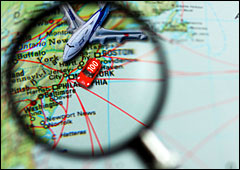Dear Umbra,
My husband asked me this one the other day and I didn’t know the answer, so I thought I’d ask an expert. Which is the more environmentally friendly method of travel: 100 people driving their own cars (let’s assume non-hybrid vehicles) to a city three hours away, or 100 people flying in a plane to the same city?
Natalie W.
North East, Pa.
Dearest Natalie,
Carpooling is one way to be efficient; here on Floor 2B we also like to questionpool. Let’s piggyback on Helen’s earlier question about the efficiency of trains vs. planes and keep practicing our carbon math.

Planes, trains calculators, and automobiles.
Most carbon emission measurements are in distance rather than time, so to be super-efficient we will decide the city is 300 miles from our starting destination. Let’s say the journey is from Philadelphia to Boston.
To recap what we learned about train rides vs. short-haul (300 miles or under) flights: planes are up to 10 times worse than trains. Short-haul flights are worse than long-haul flights per passenger-mile, because takeoff and landing use the most fuel in a flight. Flying 300 miles in the face of other, better transit choices is an egregious release of carbon.
Solo driving, though, is also fairly egregious. What, then, about this theoretical situation you pose?
Let’s say a group of 100 wedding guests charters a plane from Philadelphia to Boston. Or the wedding guests all drive, but they have so many giant gifts for the couple (organic futons, recycled-plastic fleece coats, cast iron crock pots, bicycles) that there is no room to carpool, and each must drive their own car.
For British Helen, we used emissions factors from the U.K. Department of Environment, Food, and Rural Affairs. A factor is one of the numbers in a multiplication equation; a transport emissions factor basically mathematically represents volume of fuel burned and, multiplied by a distance factor, results in an amount of carbon emitted. To compare single occupancy cars and a plane, we’ll look at the DEFRA numbers again. DEFRA’s emissions factor for medium-sized cars is 0.3442 kilograms CO2 per mile; for a short-haul plane it’s 0.1753 kg CO2 per passenger-kilometer, multiplied by two, then multiplied by 109 percent. (These last two seemingly random multipliers account for radiative forcing and uplift factor, which are plane-specific attributes that affect CO2 pollution.)
According to our DEFRA-based calculations, each wedding-bound car is emitting 104 kg CO2 over the trip; that’s a total of 10,400 kg CO2 for 100 cars. If the guests all flew, they would each emit 184 kg — times 100 passengers would be 18,400 kg CO2. I can further tell you that the Boeing 737-300 that United flies on its Philadelphia-Boston route holds around 128 passengers, so if the plane were full (wedding crashers!), the total emissions would be a bit higher.
Given that these are enough numbers and that if I add any more we’ll all stop reading, what can we conclude? Per person, this journey isn’t dramatically different from a carbon angle, with the 100 cars coming out slightly ahead. But more important, the math reminds us that no man is an island. Whether one person or four drives in the generic mid-size car, it emits about 104 kg CO2 total. So should the 100 guests choose to carpool, driving fewer cars to the wedding, their group carbon footprint can be lowered.
Dearest Natalie, I have no idea why your husband asked this question, and I bet he regrets it now. I hasten to add that I am not an expert. Still, I hope that my inexpert math, or at least the resources for doing one’s own math, will scratch whatever itch struck him, and convince us all to fly a little less often — and to carpool more.
Factor-y,
Umbra

